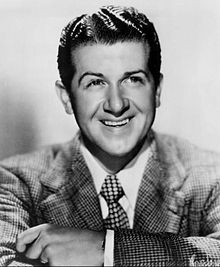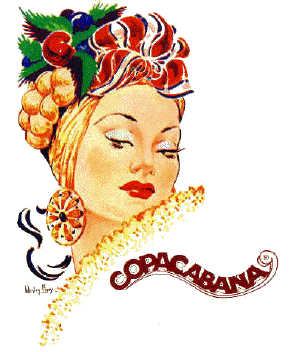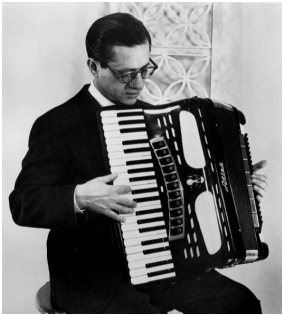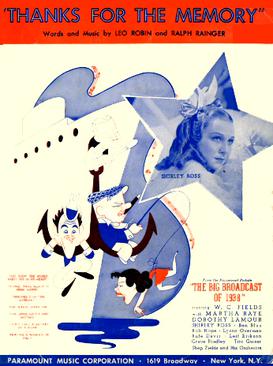
A big band remote (a.k.a. dance band remote) was a remote broadcast, common on radio during the 1930s and 1940s, involving a coast-to-coast live transmission of a big band.

A big band remote (a.k.a. dance band remote) was a remote broadcast, common on radio during the 1930s and 1940s, involving a coast-to-coast live transmission of a big band.
Broadcasts were usually transmitted by the major radio networks directly from hotels, ballrooms, restaurants and clubs. During World War II, the remote locations expanded to include military bases and defense plants. Band remotes mostly originated in major cities, including Boston, Los Angeles, New York, Philadelphia, San Francisco and Chicago.
The usual procedure involved the network sending a two-man team, announcer and engineer, with remote radio equipment to a designated location. The announcer would open with music behind an introduction:
For your dancing pleasure, Columbia brings you the music of Count Basie and his orchestra, coming to you from the Famous Door on Fifty-Second Street in New York City. [1]
The Chicago broadcasts featured bands headed by Count Basie, Frankie Carle, Duke Ellington, Jan Garber, Jerry Gray, Woody Herman, Earl Hines, Eddy Howard (from the Aragon Ballroom), Dick Jurgens, Kay Kyser (from the Blackhawk Restaurant), Coon-Sanders Original Nighthawk Orchestra (from the Blackhawk), Ted Weems, Shep Fields (from the Palmer House - Empire Room) [2] [3] and Griff Williams.
Artie Shaw's many remote broadcasts included the Rose Room of Boston's Ritz Carlton Hotel. The Blue Room of New York's Hotel Lincoln was the location of his only regular radio series as headliner. Sponsored by Old Gold cigarettes, Shaw broadcast on CBS from November 20, 1938 until November 14, 1939. Before he launched Sun Records, Sam Phillips ran regular big band remotes with the Chuck Foster orchestra and others from the Peabody Hotel Skyway Ballroom in Memphis, Tennessee. [4] The tradition continued into the 1950s with Ray Anthony doing band remotes on CBS in 1951-52. In the mid-1950s, NBC broadcast jazz club remotes on Monitor featuring Howard Rumsey, Al Hibbler and others. [5]
As early as 1923, listeners could tune in the Waldorf-Astoria Orchestra. The Oriole Orchestra (Dan Russo and Ted Fio Rito) was performing at Chicago's Edgewater Beach Hotel when they did their first radio remote broadcast on March 29, 1924, and two years later, they opened the famous Aragon Ballroom in July 1926, doing radio remotes nationally from both the Aragon and the Trianon Ballrooms. In 1929, after Rudy Vallée's Orchestra vacated Manhattan's Heigh-Ho Club to do a movie in Hollywood, Will Osborne's dance band found fame with a nationwide audience due to radio remotes from the Heigh-Ho. That same year, Phil Spitalny and his orchestra broadcast on NBC from the Hotel Pennsylvania in New York.
| External image | |
|---|---|
Here on Getty Images |
Starting in 1929, Guy Lombardo begin a series of annual New Year's Eve remote broadcasts of his "sweet" big-band music from several venues in New York City. Featuring his Royal Canadians Orchestra, Lombardo's performances continued for nearly half a century. From 1929-1959, his earliest broadcasts originated live on both the CBS and NBC radio networks from the Roosevelt Grill at the Roosevelt Hotel and were subsequently followed by both live radio and television broadcasts on the CBS network from the Ballroom at the Waldorf Astoria Hotel from 1959 until 1976. [6] Due to the widespread popularity of these broadcasts Lombardo earned the nickname "Mr. New Year's Eve". [7]
By 1930, Ben Bernie was heard in weekly remotes from Manhattan's Roosevelt Hotel. On November 24, 1937, Glenn Miller did a remote on NBC from Boston's Raymor Ballroom on Huntington Avenue (one block from Symphony Hall). On the west coast, Shep Fields and his Rippling Rhythm Orchestra could be heard in 1938 while broadcasting from the Los Angeles Biltmore Hotel after filming The Big Broadcast of 1938 in Hollywood. [8] By 1945, Fields' live performances at the famed Copacabana nightclub in New York City were also broadcast on the WOR Radio Network. [9] [10] [11]
The Glen Island casino was billed as "the mecca for music moderns" and fans from coast to coast knew that it was "just off Shore Road in New Rochelle, New York". Glen Island represented glamor and prestige, where only the best and most popular bands were featured. The casino was also considered the springboard to success for many big bands of 1930s, including those of Ozzie Nelson, Charlie Barnet, Claude Thornhill, Les Brown and the Dorsey Brothers. [12] In March 1939, Glenn Miller and his orchestra gained their big break when they were chosen to play a summer season at Glen Island. [13] Both NBC and Mutual broadcast Miller and his orchestra from the casino, an unusual dual-network remote with some 1,800 people present in the Casino ballroom. Glen Gray's Casa Loma Orchestra played at Glen Island along the water's edge almost every night. In addition, Shep Fields introduced a reconfiguration of his Rippling Rhythm Orchestra with the vocalist Toni Arden at the Glen Island Casino in 1947. [14]

A big band or jazz orchestra is a type of musical ensemble of jazz music that usually consists of ten or more musicians with four sections: saxophones, trumpets, trombones, and a rhythm section. Big bands originated during the early 1910s and dominated jazz in the early 1940s when swing was most popular. The term "big band" is also used to describe a genre of music, although this was not the only style of music played by big bands.

William James "Count" Basie was an American jazz pianist, organist, bandleader, and composer. In 1935, he formed the Count Basie Orchestra, and in 1936 took them to Chicago for a long engagement and their first recording. He led the group for almost 50 years, creating innovations like the use of two "split" tenor saxophones, emphasizing the rhythm section, riffing with a big band, using arrangers to broaden their sound, and others. Many musicians came to prominence under his direction, including the tenor saxophonists Lester Young and Herschel Evans, the guitarist Freddie Green, trumpeters Buck Clayton and Harry "Sweets" Edison, plunger trombonist Al Grey, and singers Jimmy Rushing, Helen Humes, Thelma Carpenter, and Joe Williams.
Swing music is a style of jazz that developed in the United States during the late 1920s and early '30s. It became nationally popular from the mid-1930s. The name derived from its emphasis on the off-beat, or nominally weaker beat. Swing bands usually featured soloists who would improvise on the melody over the arrangement. The danceable swing style of big bands and bandleaders such as Benny Goodman was the dominant form of American popular music from 1935 to 1946, known as the swing era, when people were dancing the Lindy Hop. The verb "to swing" is also used as a term of praise for playing that has a strong groove or drive. Musicians of the swing era include Duke Ellington, Benny Goodman, Count Basie, Cab Calloway, Jimmy Dorsey, Tommy Dorsey, Woody Herman, Harry James, Lionel Hampton, Glenn Miller, Artie Shaw and Django Reinhardt.

Gaetano Alberto "Guy" Lombardo was a Canadian and American bandleader, violinist, and hydroplane racer.

Glenn Miller and His Orchestra was an American swing dance band formed by Glenn Miller in 1938. Arranged around a clarinet and tenor saxophone playing melody, and three other saxophones playing harmony, the band became the most popular and commercially successful dance orchestra of the swing era and one of the greatest singles charting acts of the 20th century. As of 2023, Ray Anthony is the last surviving member of the orchestra.

The Copacabana is a New York City nightclub that has existed in several locations. In earlier locations, many entertainers, such as Danny Thomas, Pat Cooper, and the comedy team of Martin and Lewis, made their New York debuts at the Copacabana. The Barry Manilow song "Copacabana" (1978) is named after, and set in, the club. The nightclub was used as a setting in the films Goodfellas, Raging Bull, Tootsie, The Purple Rose of Cairo, Carlito's Way, The French Connection, Martin and Lewis, Green Book, Beyond the Sea, The Irishman, and One Night in Miami. It was also used in several plays, including Barry Manilow's Copacabana. Also, the musical film Copacabana (1947), starring Groucho Marx and Carmen Miranda, takes place in the Copacabana, as does the made-for-television film based on the Manilow hit song, in which Manilow himself starred.

Frederick Alfred Martin was an American bandleader and tenor saxophonist.

John Serry Sr. was an American concert accordionist, arranger, composer, organist, and educator. He performed on the CBS Radio and Television networks and contributed to Voice of America's cultural diplomacy initiatives during the Golden Age of Radio. He also concertized on the accordion as a member of several orchestras and jazz ensembles for nearly forty years between the 1930s and 1960s.
Wilbur Schwartz, aka Wil Schwartz or Willie Schwartz, was an American studio session clarinetist, alto saxophonist, and flutist who was widely known as a member of the Glenn Miller Orchestra.

Beatrice Ruth Wain was an American Big Band-era singer and radio personality born in the Bronx, New York City. She had several hits with Larry Clinton and His Orchestra, including "My Reverie", "Deep Purple", and "Heart and Soul". Wain and announcer Andre Baruch, her husband, co-hosted radio programs from the 1940s to the 1980s.

Shep Fields was an American bandleader who led the Shep Fields and His Rippling Rhythm orchestra during the 1930s. His distinctive Rippling Rhythm sound was featured on big band remote broadcasts from historic hotels nationwide and remained popular with audiences from the 1930's into the early 1960's.

"Thanks for the Memory" (1938) is a popular song composed by Ralph Rainger with lyrics by Leo Robin. It was introduced in the 1938 film The Big Broadcast of 1938 by Bob Hope and Shirley Ross, and recorded by Shep Fields and His Orchestra featuring John Serry Sr. on accordion in the film and vocals by Bob Goday on Bluebird Records. Dorothy Lamour's solo recording of the song was also popular, and has led to many mistakenly believing over the years that it was she who sang the tune with Hope in the film.

Theodore Salvatore Fiorito, known professionally as Ted Fio Rito, was an American composer, orchestra leader, and keyboardist, on both the piano and the Hammond organ, who was popular on national radio broadcasts in the 1920s and 1930s. His name is sometimes given as Ted Fiorito or Ted FioRito.

Leonard William Hambro, known as Lenny Hambro, was a journeyman jazz musician who played woodwinds, primarily alto saxophone, with a host of bands, orchestras, and jazz notables from the early 1940s through the mid-1960s, and continued as a session musician, music producer, booking agent, and entertainment coordinator through the mid-1990s. Early in his professional career, Hambro spelled his name "Lennie" but changed it to the former spelling in 1954, although he was occasionally referred to as "Lennie" in the press as late as 1957. Hambro broke into the profession with Gene Krupa in 1942. However, he is best known for his time as manager and assistant band leader with the New Glenn Miller Orchestra under the direction of Ray McKinley. He was well known in the Latin Jazz community and was closely associated with Chico O’Farrill.
Bob Johnstone was an American traditional pop music singer. His birthname was Robert Morton Johnston.

This Is Tommy Dorsey & His Orchestra, Vol. 1 is the first of two volumes originally released in a 1971 series by RCA Victor, which was created in response to a resurgence in big band recreations during the late '60s and early '70s, and is a reissue of 20 famous recordings by Tommy Dorsey & His Orchestra. The album was subsequently re-released in 2001 by Collectables Records.
Dan Terry was an American big band leader, arranger, and trumpet and flugelhorn player who appeared at Birdland, the world-famous jazz club, with Dinah Washington, Sarah Vaughan, Chris Connor, Johnny Smith, and other jazz luminaries.

Starin's Glen Island was a summer resort in the community of New Rochelle in Westchester County, New York, developed by shipping magnate and U.S. Congressman John H. Starin in the late 1800s. Starin's resort, referred to as "America's pleasure grounds" was the first theme park in the country. The park's original design exhibited the five cultures of the western world on individual islands linked together with piers and causeways. The extreme popularity of the park resulted in a building boom in New Rochelle in the first decade of the twentieth century.

Harry Roy Gozzard was an American jazz trumpeter. He first performed with Sam Donahue. Other members of Donahue's band included the former The Tonight Show Starring Johnny Carson bandleader Doc Severinsen, 1946 Esquire Award winner for Best New Female Vocalist Frances Wayne, Grammy Award-winning vocalist and actress Jo Stafford and popular music arranger Leo Reisman.